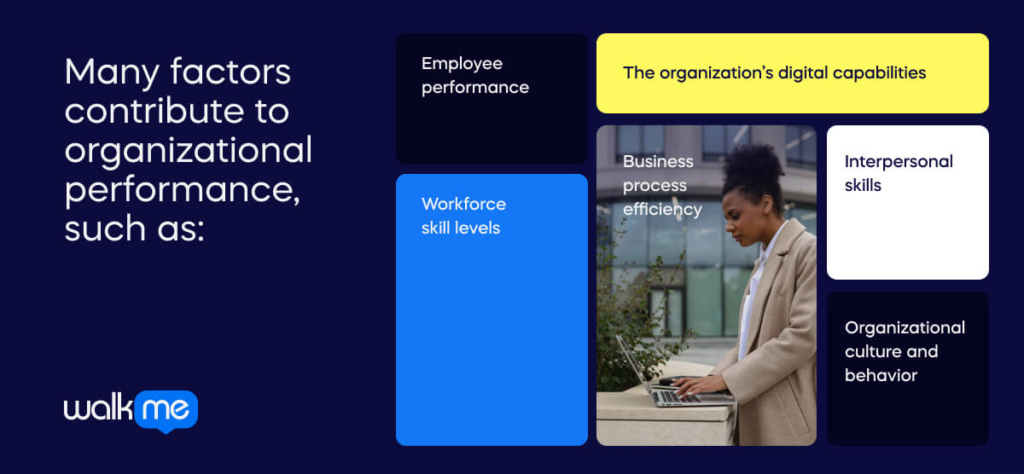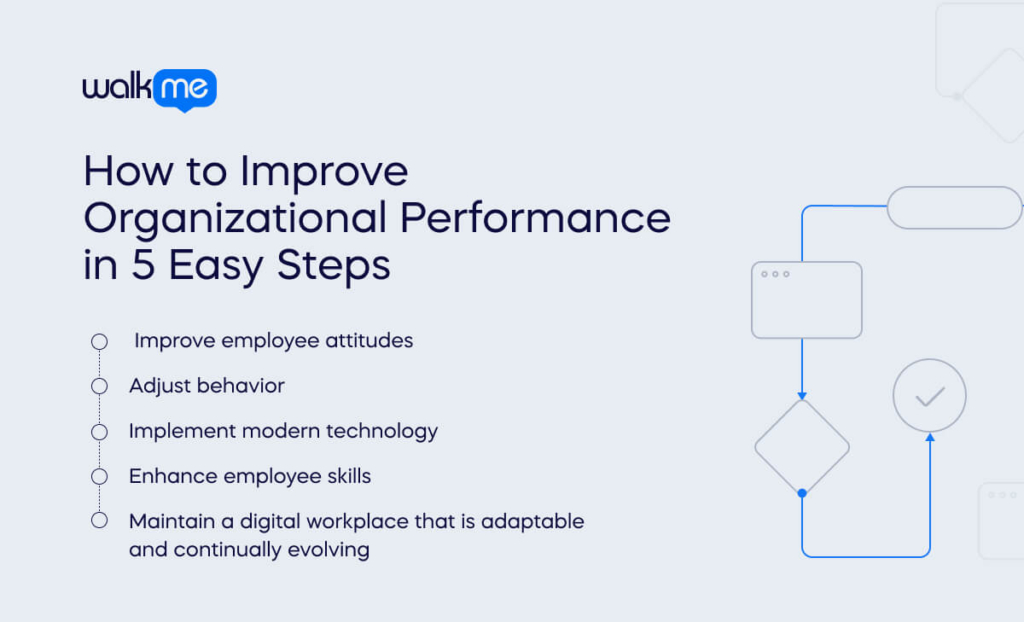Business professionals that want to know how to improve organizational performance will soon discover that there is no one-size-fits-all solution to this issue.
Many factors contribute to organizational performance, such as:

- Employee performance
- The organization’s digital capabilities
- Workforce skill levels
- Business process efficiency
- Organizational culture and behavior
Improving organizational performance, therefore, requires an approach that is flexible and addresses multiple areas.
Below, we will look at a five-step process that can do just that.
How to Improve Organizational Performance in 5 Easy Steps

Every business should start by evaluating its own circumstances, then designing an improvement process suited to its situation and its needs.
The steps covered below represent a holistic approach that covers three important areas that affect an organization’s performance – humans, tools, and the processes that link them.
To start, we will look at the human side of the equation.
1. Improve employee attitudes
Employee attitudes have a major impact on their performance.
Good attitudes positively affect output, efficiency, the work environment, and many other variables that can impact organizational performance.
Poor attitudes, on the other hand, can naturally have the opposite impact.
There is no way to completely control employees’ attitudes – and that is not necessarily a desirable aim anyhow.
However, there are ways to influence attitudes that can positively affect performance.
Organizations can, for instance:
- Implement corporate well-being programs, which help improve employee health, lower stress levels, and improve the work environment
- Begin offering activities that improve teamwork, such as team-building activities, social gatherings at the workplace, and corporate retreats
- Use employee surveys to uncover problems that cause friction in the workplace, then fix those as best as possible
Employees are individuals, and therefore it is impossible for an organization to take full responsibility for their attitudes and behavior in the workplace.
However, the right actions can have a positive influence on employee attitudes and performance.
2. Adjust behavior
There is a subtle but important difference between attitudes and behavior.
Attitudes refer to emotions, feelings, and emotional postures.
A behavior, however, refers to actions.
There is a connection between the two – attitudes affect behavior, for instance.
But influencing attitudes alone is not enough.
An employee that has a great attitude, for instance, will not automatically perform all their required duties.
To ensure employee behavior is aligned with an organization’s needs, an organization should:
- Clearly articulate the required activities and behaviors
- Maintain accountability
- Reward and incentivize
By influencing employees behavior and attitudes, organizations can have a positive impact on both the actions and the emotions of employees.
3. Implement modern technology
Another important factor that contributes to an organization’s success is technology.
This is especially true today, in the digital age.
The right technology, after all, can:
- Improve business process efficiency
- Enhance the customer experience
- Increase productivity across every area of the organization
- Enable innovation and new business functions
Of course, finding the right technology is easier said than done, and it can be quite a tall task.
Digital adoption and digital transformation can even involve large organizational changes over long periods of time.
However, in today’s digitally-driven economy, such changes are necessary – and they can even enhance an organization’s competitive position, fuel growth, and inspire innovation, among many other things.
4. Enhance employee skills
Technology, behavior, and attitudes are only beneficial if employees possess the right skills.
Skilled employees are more productive, efficient, and satisfied. Improved employee performance also directly contributes to improved organizational performance.
And, as with digital adoption, employee learning is becoming a crucial business function.
To improve employee skills, organizations should:
- Streamline the employee onboarding process
- Develop modern, technology-driven employee training programs
- Continually optimize those training efforts
Because today’s organizations are digitally-powered, employee training is a matter of survival.
Effective training, after all, improves:
- Software utilization and ROI
- Employee productivity and performance
- Organizational performance
For more information on employee training, it pays to research digital adoption, digital adoption platforms, and other digital training solutions.
5. Maintain a digital workplace that is adaptable and continually evolving
The digital workplace is where all of these pieces come together.
Naturally, it is not the only contributor to organizational performance.
But workers, their tools, and the workplace do play a major role in organizational effectiveness.
Also – and just as importantly – organizations must continually evolve the workplace in order to keep up with the changing economy.
This means:
- Following the recommendations listed earlier
- Focusing on organizational performance first, then the individual components that contribute to that performance
- Implementing structured change management, in order to change efficiently and effectively
Modern workplaces are driven by change, which makes change management just as critical as the other variables covered earlier.
After all, organizations that can change effectively will better be able to keep up with today’s dynamic, ever-evolving business world.

